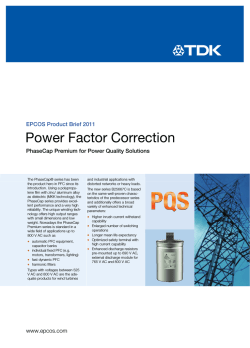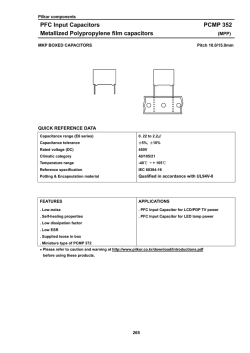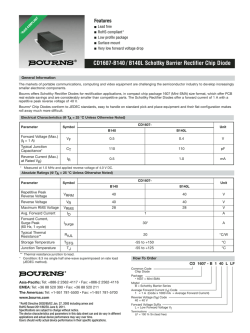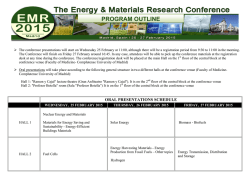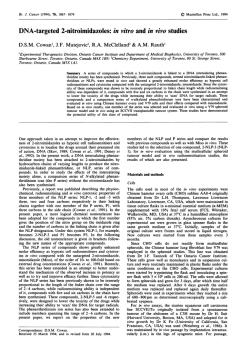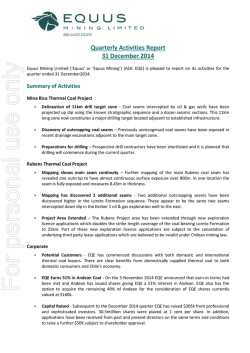
Study on Electrochemical Capacitance using Templated Carbons
nº37 / Septiembre 2015 Study on Electrochemical Capacitance using Templated Carbons Estudio de la capacidad electroquímica mediante carbones nanomoldeados H. Nishihara1,*, H. Itoi2, K. Nueangnoraj1, R. Berenguer3, A. Berenguer-Murcia4, R. Ruiz-Rosas4, D. Cazorla-Amorós4, E. Morallón4, T. Kyotani1 1 Institute of Multidisciplinary Research for Advanced Materials, Tohoku University, 2−1−1 Katahira, Aoba, Sendai 980−8577, Japan. 2 Department of Applied Chemistry, Faculty of Engineering, Aichi Institute of Technology, 1247 Yachigusa, Yakusa, Toyota 470−0392, Japan. 3 Department of Chemical Engineering, School of Industrial Engineering, University of Malaga, Campus de Teatinos s/n,29071 Malaga, Spain. 4 Instituto Universitario de Materiales de Alicante. Universidad de Alicante. Apdo. 99. E-03080 Alicante, Spain. * Corresponding author: [email protected] Abstract The template carbonization technique enables the production of porous carbons and carbon-based composites with precisely designed, controlled pore structures. The resulting templated carbons are therefore useful to investigate and understand the relation between carbon nanostructure and electrocapacitive properties. In this short review paper, we introduce our works on electrochemical capacitance using zeolite-templated carbons and carbon-coated anodic aluminum oxide. Resumen La técnica de nanomoldeo mediante carbonización de plantillas sólidas infiltradas permite la preparación y el diseño de materiales carbonosos porosos, tanto puros como compuestos, donde las estructuras porosas son fácilmente definibles y controlables. Los carbones nanomoldeados resultantes son muy útiles como materiales modelo para estudiar las relaciones entre la nanostructura del carbón y sus propiedades electrocapacitivas. En este trabajo, realizamos una breve revisión de nuestros estudios sobre la capacidad electroquímica utilizando carbones nanomoldeados obtenidos como réplica de una zeolita o por recubrimiento de óxido de aluminio anodizado. 1. Introduction An electrochemical capacitor is an electric storage device which can be repeatedly charged and discharged. Compared with secondary batteries, the capacitor has several advantages such as higher power density and longer cycle life, though its energy density is much lower than those of the secondary batteries. There are mainly two strategies in the development of the capacitor electrode materials; focusing on the increase of (i) the power density and (ii) the energy density. In this short review, we introduce our previous works regarding these two strategies, using uniform porous materials prepared by the templated carbonization technique. 2. Electrochemical properties of zeolite-templated carbons 6 Our group has developed the templated carbonization technique which allows to produce carbon materials having well-tailored nanostructures [1-4]. When a zeolite, a microporous inorganic crystal, is used as a template, an ordered microporous carbon, zeolitetemplated carbon (ZTC) can be produced [1, 4-6], according to the scheme shown in Figure 1. Figure 1. A synthesis scheme of ZTC together with TEM images of zeolite Y and ZTC. Scale bars in the TEM images are 10 nm. Black, blue, and red spheres in the models correspond to carbon, hydrogen, and oxygen atoms, respectively. Reprinted with permission [4]. Copyright 2012 WILEY-VCH Verlag GmbH & Co. KGaA, Weinheim. Figura 1. Esquema de la preparación de ZTC mostrando las imágenes TEM de la zeolita Y y el ZTC. La barra de escala en las imágenes es 10 nm. En los modelos moleculares, las esferas negras, azules y rojas corresponden a átomos de carbono, hidrógeno y oxígeno, respectivamente. ZTC consists of single-layer graphene nanoribbon (Figure 1), and its graphene framework is fully exposed without any stacking. In addition to both faces of the basal plane of the graphene (theoretical surface area is 2627 m2 g–1), the contribution of the edge sites to surface area is significant, and thus ZTC has very high surface area of 3000-4000 m2 g–1 [7]. Accordingly, ZTC shows a high electric doublelayer capacitance [8-10]. A valuable advantage of ZTC is its excellent rate performance [8-10]. The three-dimensionally arrayed and interconnected Bol. Grupo Español Carbón pores realize a fast ion-transfer despite its small pore size (1.2 nm). Many people believe that mesoporous, macroporous, or hierarchical porous carbons could be good electrode materials for high-power supercapacitors. However, the introduction of such large pores seriously decreases the packing density of the electrode layer, resulting in a low volumetric capacitance. ZTC is able to achieve both a good rate performance and a high volumetric capacitance, the latter of which comes from the fact that ZTC does not possess unnecessary meso- nor macropores. Figure 2 shows the volumetric capacitance versus current density for ZTC and reference activated carbons (MSC30 and A20) [9]. It is found that ZTC shows a high volumetric capacitance and a good rate performance. Figure 2. Volumetric capacitance versus current density for ZTC and activated carbons (MSC30 and A20). Reprinted with permission [9]. Copyright 2011 American Chemical Society. Figura 2. Capacidad volumétrica frente a densidad de corriente para el ZTC y dos carbones activados (MSC30 y A20). We have prepared also a binderless thin-film electrode consisting of ZTC, formed directly on a current collector film [11]. The obtained film electrode exhibits a high area capacitance (10–12 mF cm–2), compared with other microcapacitors. In addition, the film electrode is free from inter-particle resistance, and ultrahigh rate capability is achieved: the formation of double-layer capacitance could be confirmed at an ultra-high scan rate of 10000 mV s–1. ZTC has another interesting feature as a pseudocapacitive material. ZTC has a very large amount of edge sites [6], which is about 10times larger than conventional activated carbons, and a large number of oxygen functional groups can be easily introduced into the edge sites by electrochemical oxidation [12]. By tuning the oxidation condition, it is possible to introduce electrochemically active quinone groups with a high selectivity [8]. Figure 3 shows cyclic voltammogram of ZTC in 1M H2SO4 electrolyte. In an acidic electrolyte, ZTC is significantly oxidized and a large amount of quinone groups are introduced into the edge sites, without serious damage to its nanographene framework [8]. Thus, ZTC exhibits very high capacitance (ca. 500 F g–1). Despite its high capacitance and excellent rate capability, ZTC unfortunately suffers from intense hydrogen evolution at a negative potential range in an acidic electrolyte. To take advantage of the ability of ZTC, we constructed an asymmetric capacitor in which ZTC and an ultrastable KOH-activated carbon are used as a positive electrode and a negative one, respectively [13]. The latter was prepared by KOH activation of Spanish anthracite [14]. The asymmetric capacitor can be operated with the working voltage of 1.4 V, and exhibits an energy density that is comparable to those of conventional capacitors utilizing organic electrolytes, thanks to the large pseudocapacitance of ZTC. Thus, ZTC is advantageous to construct asymmetric capacitors, as a high-capacity positive electrode in acidic electrolytes. 3. Investigation of the effect of N- and B-doping by using a model porous material It is well known that doping of heteroatoms, such as B, N, and P, into porous carbons is an effective way to enhance the electrochemical capacitance. Figure 3. Cyclic voltammogram of ZTC measured between –0.1 and 0.8 V vs. Ag/AgCl in 1M H2SO4 at 25 °C, together with illustrations which represent the structure change of ZTC by electrochemical oxidation (during the first positive-direction scan) and the subsequent redox reaction of quinone/hydroquinone conversion. Figura 3. Voltagrama cíclico del ZTC, registrado entre –0.1 y 0.8 V vs. Ag/AgCl en H2SO4 1M a 25 °C, junto con ilustraciones de la oxidación electroquímica del ZTC (durante el primer barrido hacia potenciales positivos) y de la reacción redox subsiguiente quinona/ hidroquinona. 7 nº37 / Septiembre 2015 So far, many research groups have indeed reported a positive effect of such heteroatom doping in both aqueous and organic electrolyte solutions [4]. However, heteroatom doping usually alters the pore structure of a carbon matrix, and this makes it difficult to assess the sole effect of heteroatom doping, because the pore structure is also one of the crucial factors affecting electrochemical capacitance. To acquire better understanding about the effect of the heteroatom doping, we have prepared model porous materials by uniform carbon coating on anodic aluminum oxide (AAO), as shown in Figure 4 [15]. Carbon-coated AAO thus prepared has uniform-sized cylindrical mesopores with a diameter of 16 nm, and is free from any other pores, such as ultramicropores and micropores. In addition, it is possible to introduce B or N into the carbon layer. Thus, a series of mesopores completely coated with pure-, N-doped, or B-doped carbon layer were prepared, and their electrochemical properties were systematically examined both in aqueous (Figure 5) and organic electrolyte solutions [15]. It was revealed that the improvement in electrocapacitive properties due to the heteroatom doping is caused by its pseudocapacitance, not by other factors, such as the increase in wettability, conductivity, and spacecharge-layer capacitance, in a large mesopores. templated carbonization technique, we can reveal the relation between carbon nanostructure and electocapacitive properties. Acknowledgments This research was partially supported by the Strategic International Cooperative Program, Japan Science and Technology Agency (T.K.) and MINECO (Spanish-Japanese project PRI-PIBJP-2011-0766); and a Grant-in-Aid for Scientific Research (B), 26286020 (H.N.). This research was partially supported also by Nano-Macro Materials, Devices and System Research Alliance and by Network Joint Research Center for Materials and Devices. References [1] Kyotani T, Nagai T, Inoue S, Tomita A. Formation of new type of porous carbon by carbonization in zeolite nanochannels. Chem Mater 1997;9(2):609-15. [2] Kyotani T, Sonobe N, Tomita A. Formation of highly orientated graphite from polyacrylonitrile by using a twodimensional space between montmorillonite lamellae. Nature 1988;331(6154):331-3. [3] Kyotani T, Tsai LF, Tomita A. Preparation of ultrafine carbon tubes in nanochannels of an anodic aluminum oxide film. Chem Mater 1995;7(8):1427-8. [4] Nishihara H, Kyotani T. Templated nanocarbons for energy storage. Adv Mater 2012;24(33):4473-98. [5] Ma ZX, Kyotani T, Tomita A. Preparation of a high surface area microporous carbon having the structural regularity of Y zeolite. Chem Commun 2000;(23):2365-6. [6] Nishihara H, Yang QH, Hou PX, Unno M, Yamauchi S, Saito R, Paredes JI, Martinez-Alonso A, Tascon JMD, Sato Y, Terauchi M, Kyotani T. A possible buckybowl-like structure of zeolite templated carbon. Carbon 2009;47(5):1220-30. [7] Figure 4. Schematic for the synthesis process of the carbon coated AAO: (a) AAO template and (b) carbon-coated AAO. Reprinted with permission [15]. Copyright 2009 American Chemical Society. Figura 4. Esquema de la preparación de un carbón nanomoldeado obtenido por recubrimiento de óxido de aluminio anodizado (AAO): (a) plantilla de AAO y (b) AAO recubierto del carbón nanomoldeado. Nishihara H, Kyotani T, Zeolite-Templated Carbon–Its Unique Characteristics and Applications, in Novel Carbon Adsorbents, Tascon JMD ed. Elsevier: 2012; p 295-322. [8] Itoi H, Nishihara H, Ishii T, Nueangnoraj K, BerenguerBetrian R, Kyotani T. Large qseudocapacitance in quinonefunctionalized zeolite-templated carbon. Bull Chem Soc Jpn 2014;87(2):250-7. [9] Itoi H, Nishihara H, Kogure T, Kyotani T. Threedimensionally arrayed and mutually connected 1.2-nm nanopores for high-performance electric double layer capacitor. J Am Chem Soc 2011;133(5):1165-7. [10] Nishihara H, Itoi H, Kogure T, Hou PX, Touhara H, Okino F, Kyotani T. Investigation of the ion storage/transfer behavior in an electrical double-layer capacitor by using ordered microporous carbons as model materials. ChemEur J 2009;15(21):5355-63. [11] Figure 5. Capacitance of carbon-coated AAOs versus current density in 1M H2SO4 at 25 °C. Reprinted with permission [15]. Copyright 2009 American Chemical Society. Figura 5. Capacidad de varios carbones nanomoldeados sobre AAO frente a la densidad de corriente, en H2SO4 1M a 25 ºC. 4. Summary 8 ZTC, an ordered microporous carbon, achieves both a high volumetric capacitance and an excellent rate performance at the same time, due to its three-dimensionally interconnected ordered pores. In addition, its nanographene-based framework contains a large amount of active edge sites which can be functionalized with electrochemically active quinone groups. We have demonstrated that carboncoated anodic aluminum oxides are good model mesoporous materials for the understanding about the effects of the heteroatom-doping. Thus, by using the model porous carbon materials prepared by the Berenguer-Murcia A, Ruiz-Rosas RR, Garcia-Aguilar J, Nueangnoraj K, Nishihara H, Morallon E, Kyotani T, Cazorla-Amoros D. Binderless thin films of zeolitetemplated carbon electrodes useful for electrochemical microcapacitors with ultrahigh rate performance. Phys Chem Chem Phys 2013;15(25):10331-4. [12] Berenguer R, Nishihara H, Itoi H, Ishii T, Morallon E, Cazorla-Amoros D, Kyotani T. Electrochemical generation of oxygen-containing groups in an ordered microporous zeolite-templated carbon. Carbon 2013;54:94-104. [13] Nueangnoraj K, Ruiz-Rosas R, Nishihara H, Shiraishi S, Morallon E, Cazorla-Amoros D, Kyotani T. Carbon-carbon asymmetric aqueous capacitor by pseudocapacitive positive and stable negative electrodes. Carbon 2014;67:792-4. [14] Lozano-Castello D, Lillo-Rodenas MA, Cazorla-Amoros D, Linares-Solano A. Preparation of activated carbons from Spanish anthracite I. Activation by KOH. Carbon 2001;39:741-9. [15] Kwon T, Nishihara H, Itoi H, Yang QH, Kyotani T. Enhancement mechanism of electrochemical capacitance in nitrogen-/boron-doped carbons with uniform straight nanochannels. Langmuir 2009;25(19):11961-8.
© Copyright 2025
